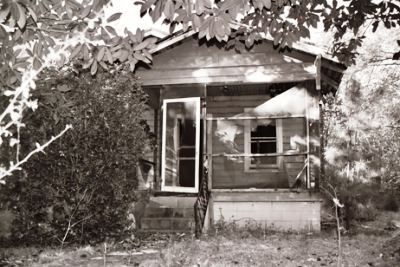
Okay, I'm back from a couple weeks down in the South. Most of the time I had to actually do work, but I made it to a few new places and got some photos. People seemed to like the brick factory shots and I went back there and got some more. There's plenty of survey flags, but the bulldozers aren't rolling yet. If the pictures turn out well I might put some more of the factory up. Yes, IF. I don't have a digital camera and I don't know what the shots look like until I develop them. Remember that feeling? Some of the pictures I've posted were even taken with a disposable, which is a good way to uselessly burn through a lot of money.
Anyway, above is a photo of a house in the woods off of Buena Vista in N. Augusta, SC. As usual, the occupants left lots of belongings, including a strange mannequin torso. The last two shots in the series are of a tarpaper shack just beyond the house in an overgrown powerline cut. This shack was kinda creepy and the trash was stacked high on the floor, making walking difficult (and dangerous). The most recent date found was off a football sports page from 1982. Don't panic, that's a DOLL lying in the filth. It was about 3 feet tall. Otherwise, I don't have much to say about this place. Who knows who lived there, what they did, or why they left? So, it being the night before Christmas and all, I thought I'd tell you the charming tale of the Hamburg Riot of 1876. Just throw another log on the fire, curl up with your favorite blanket, and enjoy a glimpse of history from the ghost of race relations past.
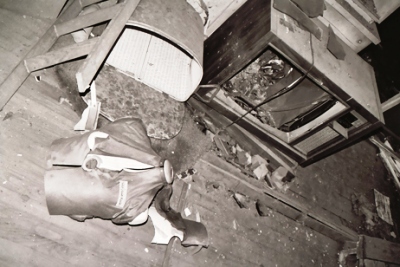
In the 1870's Federal troops were leaving the South and Reconstruction was losing momentum. Some southern states had reverted to keeping blacks from voting and the all-white Democratic administrations that followed were called "Redeemer" governments. However, South Carolina was one of only three states where the US Army was still present, preventing a "Redeemer" administration, and racial tensions were high. Some in the state argued that each white Democrat should find a way to keep at least one black man from voting, thus making it more likely that a Democratic candidate would be elected to office. Remember, Lincoln was a Republican. However, the Democratic Party was generally in disarray and couldn't even agree on candidates. It was against this political backdrop that the Hamburg Riot took place.
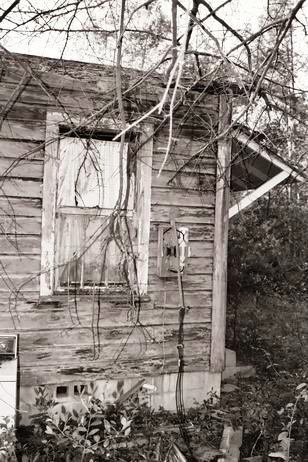 By the summer of 1876, Hamburg's prosperity was on the wane (see: previous post) and most white residents had left. The town was now populated largely by African-Americans with a few openly hostile white citizens hanging around. On July 4 there was an Independence Day parade and members of the local black militia were marching down the street when two white farmers ordered them to halt so they could move their wagon through. The militia members didn't want to stop marching and some arguments ensued. However, eventually the parade was stopped and the wagon allowed to pass.
By the summer of 1876, Hamburg's prosperity was on the wane (see: previous post) and most white residents had left. The town was now populated largely by African-Americans with a few openly hostile white citizens hanging around. On July 4 there was an Independence Day parade and members of the local black militia were marching down the street when two white farmers ordered them to halt so they could move their wagon through. The militia members didn't want to stop marching and some arguments ensued. However, eventually the parade was stopped and the wagon allowed to pass.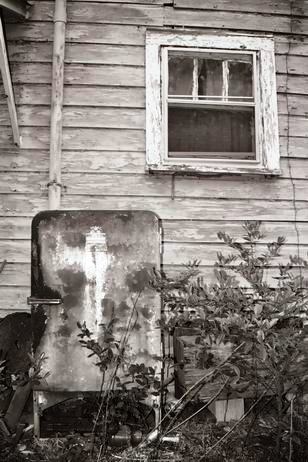 The next day the two farmers went to the courthouse and demanded that the militia captain be arrested. The captain thought this was absurd, said as much, and was then ordered to stand trial for contempt of court on July 8, 1876. The members of the black militia gathered together in town, refusing to disarm. Some fighting began whereupon the white citizens recruited 100 men from Augusta and returned to the scene with...a cannon! After nightfall the militia men tried to escape, but 25 were captured and one killed. The following day, up to eight more captives were brutally murdered and the homes of the black townspeople were looted. The number of African-Americans killed seems to vary from 6 to 9, but everyone agrees that during the looting one white man was killed. This was probably not what Joe Strummer had in mind when he called for a white riot exactly 100 years later.
The next day the two farmers went to the courthouse and demanded that the militia captain be arrested. The captain thought this was absurd, said as much, and was then ordered to stand trial for contempt of court on July 8, 1876. The members of the black militia gathered together in town, refusing to disarm. Some fighting began whereupon the white citizens recruited 100 men from Augusta and returned to the scene with...a cannon! After nightfall the militia men tried to escape, but 25 were captured and one killed. The following day, up to eight more captives were brutally murdered and the homes of the black townspeople were looted. The number of African-Americans killed seems to vary from 6 to 9, but everyone agrees that during the looting one white man was killed. This was probably not what Joe Strummer had in mind when he called for a white riot exactly 100 years later. 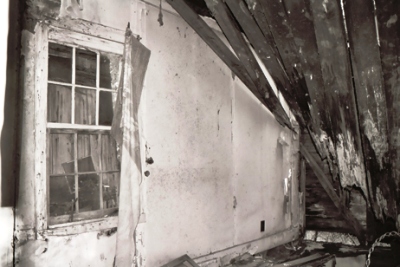
Further skirmishes erupted in Aiken, where 5000 men on horseback were reported to have gathered to aid 60 men being charged with murder. Despite this account coming from a Clemson College publication, the overtly racist tone of the source makes me question the figures. In any case, serious violence also followed in Ellenton, SC on September 15, 1876. According to Benjamin Tillman, "no one ever knew how many Negroes were killed, but there were forty or fifty or a hundred." The period around the Hamburg Riot was the beginning of the "red-shirt" movement, in which Democrats wore red shirts to protest "scalawags," considered traitors for cooperating with US troops, and "carpetbaggers," who came from the North, at least ostensibly to aid with Reconstruction. These events galvanized the white people of South Carolina and they were able to elect a Democratic governor, Wade Hampton III, later that year. (Remember, his family once owned the Goodale Inn.) Thus South Carolina became a "Redeemed" state, and the Hamburg Riot a symbol of racist violence to the North and self-determination to the South. Seven white men were indicted for the murders committed during the Hamburg Riot, but as soon as the new administration assumed office, all charges were dropped. The riot also kick-started the career of Benjamin Tillman, known affectionately as Pitchfork Ben after he threatened to stick a pitchfork in President Grover Cleveland.
"The purpose of our visit was to strike terror, and the next morning when the negroes who had fled to the swamp returned to the town, the ghastly sight which met their gaze of seven dead negroes lying stark and stiff certainly had its effect. The state of South Carolina has disenfranchised all of the colored race that it could under the 13th, 14th, and 15th Amendments. We have done our level best, we have scratched our heads to find out how we could eliminate the last one of them, and we would have done it if we could, we took the government away. We stuffed ballot boxes. We shot them. We are not ashamed of it."
Or this, in a Congressional address:
"I have three daughters, but so help me God, I had rather find either one of them killed by a tiger or a bear and gather up her bones and bury them, conscious that she had died in the purity of her maidenhood, than to have her crawl to me and tell me the horrid story that she had been robbed of the jewel of her womanhood by a black fiend."
If you want a bit more information, within the context of violence in America, go here. A cartoon drawn at that time, featuring Lady Justice holding unbalanced scales of men killed in the riot is out there on the internet, too. Finally, a book has been written about Tillman, called "Tightening the Noose: Ben Tillman and the Reconstruction of White Supremacy," by Stephen Kantrowitz. I haven't read it yet, but would like to. A review of the book, including more quotes and biography, is here.
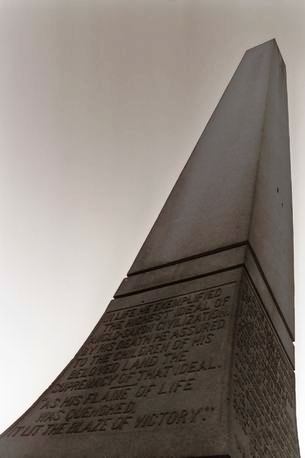 In the center of North Augusta there's a monument to the Hamburg Riot. Only, it commemorates the single white victim, whose name I've forgotten. Meriwether something, I think. It reads: "In life he exemplified the highest ideal of Anglo-Saxon civilization. By his death he assured to the children of his beloved land the supremacy of that ideal. 'As his flame of life was quenched it lit the blaze of victory.'" Now, I would just like to say, the Hamburg Riot was a long time ago and you'll find racists everywhere you go, as you'll find people that couldn't care less about skin color. This is not an indictment of southerners or their culture, only a glimpse of an ugly footnote in history. And there's plenty of ugly history to go around. Now the monument on the other hand...
In the center of North Augusta there's a monument to the Hamburg Riot. Only, it commemorates the single white victim, whose name I've forgotten. Meriwether something, I think. It reads: "In life he exemplified the highest ideal of Anglo-Saxon civilization. By his death he assured to the children of his beloved land the supremacy of that ideal. 'As his flame of life was quenched it lit the blaze of victory.'" Now, I would just like to say, the Hamburg Riot was a long time ago and you'll find racists everywhere you go, as you'll find people that couldn't care less about skin color. This is not an indictment of southerners or their culture, only a glimpse of an ugly footnote in history. And there's plenty of ugly history to go around. Now the monument on the other hand...Merry Christmas. And to all, a good night.
10 comments:
UPDATE: The white man who was killed in the Hamburg Riot was McKie Meriwether. James Cook was the first black man to be shot, with five others killed later that night. Also, I’ve recently learned that the two “farmers” that demanded that the Independence Day parade be stopped were Henry Getzen and Thomas Butler, who were on the way back to their plantation. Robert Butler, Thomas’s father, placed charges against the militia before Prince Rivers and later engaged lawyer Matthew Calbraith Butler (unrelated) to press harder. Robert Butler, of course, was the first recorded owner of Getzen’s Pond, which got its name after Butler’s daughter married Henry Getzen. I presume this would be Henry Getzen Jr., son of the Henry Getzen mentioned above. Thanks to Peter Hughes for the fascinating tidbit. Wikipedia has also recently added some information on the Hamburg Riot.
Mr. Robert Scott of Clarks Hill (descendant of "Ready Money Scott" who lived there in the late 1700s) suggests moving the present monument to an old Meriwether family cemetery. That would keep it as a memory but would shift its aggressive language out of the city's most prominent park. Personally I think anybody that wants to keep the monument where it is can contribute towards another in rememberance of the other five citizens that were killed. If there is insufficient response, Meriwether gets moved according to Robert's suggestion.
I visited North Augusta this weekend after having driven through this quaint looking town a month or so ago in the rain and deciding that I should come back when I could spend more time. But I was absoutely appalled when I discovered the Meriwether monumentand and its racist, offensive language. I was shocked that such a thing could even exist on publicly owned land in this day and age. The Hamburg Riot was an atrocious episode in South Carolina history and this monument should not be allowed to stand on public property. Some may think otherwise, but I will never spend a cent or another minute of my time in North Augusta so long as this monument stands on Public land.
There's a book out January 2008 called "The Bloody Shirt" by Stephen Budiansky. Someone said it is like a Profiles in Courage of Reconstruction. Anyway it gets into the Hamburg Massacre and it's pretty raw. I don't guess it will be a best seller in North Augusta, South Carolina.
Sounds like an interesting book. I doubt there's much to say about the Hamburg Massacre that would be pleasant. There's plenty of people in North Augusta that are appalled by the massacre. There's probably plenty of folks that have never even HEARD of the massacre, actually. They really should take down that monument though.
Thanks for the info and stopping by. I'll check into that book.
John
I live in Columbia County, GA, and I look forward to dropping by and finding this monument next time I'm in North Augusta. I've linked to this blog entry from the blog I created to gather information about a monument at the 1000 block of Greene St in Augusta, GA, http://greenestmonument.blogspot.com/.
though i agree with the person about how anyone of this day and time could allow such things as a statue to stand is way past anyones thinking, but now lets step back for a sec and remember the erea that this took place and to where it took place, its nothing to be proud of as Americans or Southerns, but its a part of History, there is alot of things that this country could Take down or destory..but then we would be destorying history, if you would like to get in touch with me as i am a History Major, please feel free at marsengill5150@yahoo.com, i will answer or listen to your side, but please people try to remember, you might not like it or be proud of it, but its a part of this country and this states History..thank you for your time, my name is Richard
Hi Richard,
Thanks very much for your comment. I definitely see your point. However, every time I read what's on that monument I'm shocked. It is so blatantly racist and glorifies an event which is appalling. Yet, you're correct, it is history and, in some sense, perhaps simply destroying the monument removes an aspect of SC's history that people should know about, negative as it may be. Maybe there is a way to make the area around the monument more educational and more of a memorial to the African-Americans who were really the victims of the Hamburg Massacre.
A book has recently been released, The Bloody Shirt, by Stephen Budiansky that contains a segment on the Hamburg Riot. I have not had a chance to read the book yet--I've been traveling for some time now--but will as soon as I get a chance. I have watched this lecture by the author though, and the Riot and the monument are dealt with in some detail:
http://www.booktv.org/program.aspx?ProgramId=9575&SectionName=History&PlayMedia=No
Note that the author references local historian Peter Hughes, who runs the Hamburg/Henry Shultz website:
http://www.arete-designs.com/hamburg/
Thanks again for your comment. I think a dialogue regarding the fate of the monument is crucial and it seems that such a thing is starting to occur.
Best,
John
I was going to try and visit this house at one point, but now I don't. I found this by looking at OpenStreetMap and it showed a road that I thought didn't exist. By virtually exploring on Google Earth, and viewing the Historical Imagery, you can get some clearer aerial views of the house. I couldn't see the tarp shed, but considering you took the photos almost 7 years ago, I'm not surprised. I recently moved to the area, and am surprised by the amount of abandoned and crumbling buildings.
Yeah, Augusta does have a surprising number of abandoned structures. I grew quite fond of some of them, which is why I started this whole photography/history enterprise in the first place.
Enjoy Augusta! You might have to dig a bit to find things you like, but there's a lot to explore in the CSRA.
JM
Post a Comment